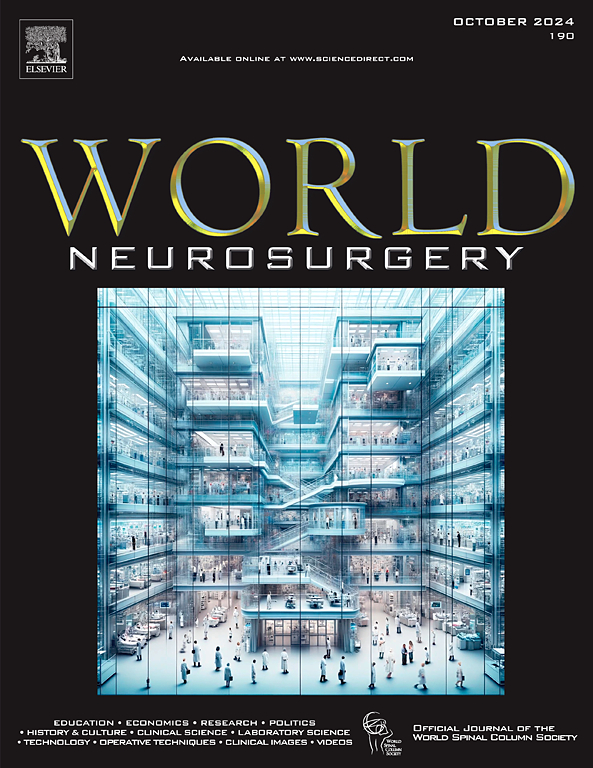Building and Verifying a Prediction Model for Deep Vein Thrombosis Among Spinal Cord Injury Patients Undergoing Inpatient Rehabilitation
IF 1.9
4区 医学
Q3 CLINICAL NEUROLOGY
引用次数: 0
Abstract
Objective
To explore the relevant variables that contribute to deep vein thrombosis (DVT) among spinal cord injury (SCI) patients undergoing inpatient rehabilitation and to build and validate a nomogram model that predicts DVT risk.
Methods
By convenience sampling, 558 SCI patients who were hospitalized at a tertiary-level Grade A general hospital in Anhui Province, China between January 2017 and March 2022 were chosen as the study subjects. They were split into 2 groups at random, one for training (n = 446) and the other for validation (n = 112). The ratio was 8:2. The clinical information of patients was gathered, including sociodemographic characteristics, data about disease characteristics, and examinations pertaining to laboratories. The related factors of DVT among SCI patients undergoing inpatient rehabilitation were analyzed using both univariate and multivariate logistic regression. Using the variables identified by the multivariate logistic regression analysis, we constructed a predictive nomogram model with the aid of the R software. The model’s predictive accuracy for assessing the risk of DVT was validated through the use of receiver operating characteristic curves and calibration plots.
Results
Prothrombin time, D-dimer, age, and Caprini score were independent related factors for DVT among SCI patients undergoing inpatient rehabilitation, according to multivariate logistic regression analysis (odds ratio > 1, P < 0.05). These 4 variables selected by the multivariate logistic regression analysis were used to build a nomogram risk model, which was found to have strong predictive capacity for predicting the risk of DVT among SCI patients undergoing inpatient rehabilitation. The nomogram model’s area under the receiver operating characteristic curve in the training group and validation group was 0.793 and 0.905, and the 95% confidence intervals were 0.750∼0.837 and 0.830∼0.980, separately, indicating good discrimination of the nomogram model. A good calibration of the model was shown by the calibration curve, which was well consistent between the model’s predicted probability and the actual frequency of DVT in both the training and validation groups.
Conclusions
Prothrombin time, D-dimer level, age, and Caprini score are independent related factors for DVT among SCI patients undergoing inpatient rehabilitation. According to the variables mentioned previously, a nomogram model was constructed that can accurately and easily predict DVT risk among SCI patients undergoing inpatient rehabilitation. This facilitates the early identification of high-risk groups and the timely implementation of prevention, treatment, rehabilitation, and nursing strategies by clinical medical staff.
在接受住院康复治疗的脊髓损伤患者中建立并验证深静脉血栓形成预测模型。
目的探讨导致住院康复的脊髓损伤患者深静脉血栓形成(DVT)的相关变量,并建立和验证预测DVT风险的提名图模型:通过方便抽样,选取2017年1月至2022年3月期间在安徽省某三级甲等综合医院住院治疗的558名脊髓损伤患者作为研究对象。他们被随机分成两组,一组用于训练(n = 446),另一组用于验证(n = 112)。两组比例为 8:2。研究人员收集了患者的临床信息,包括社会人口学特征、疾病特征数据和实验室相关检查。采用单变量和多变量逻辑回归分析了住院康复的脊髓损伤患者深静脉血栓形成的相关因素。利用多变量逻辑回归分析确定的变量,我们借助 R 软件构建了一个预测提名图模型。通过使用接收者操作特征曲线(ROC)和校准图,验证了该模型在评估深静脉血栓风险方面的预测准确性:结果:根据多变量逻辑回归分析,凝血酶原时间(PT)、D-二聚体、年龄和卡普里尼评分是住院康复的脊髓损伤患者深静脉血栓形成的独立相关因素(OR > 1,PC结论:凝血酶原时间、D-二聚体、年龄和卡普里尼评分是脊髓损伤患者深静脉血栓形成的独立相关因素:凝血酶原时间、D-二聚体水平、年龄和卡普里尼评分是住院康复治疗的脊髓损伤患者深静脉血栓形成的独立相关因素。根据上述变量,我们构建了一个提名图模型,该模型可准确、简便地预测住院康复治疗的脊髓损伤患者发生深静脉血栓的风险。这有助于临床医务人员及早识别高危人群,及时实施预防、治疗、康复和护理策略。
本文章由计算机程序翻译,如有差异,请以英文原文为准。
求助全文
约1分钟内获得全文
求助全文
来源期刊

World neurosurgery
CLINICAL NEUROLOGY-SURGERY
CiteScore
3.90
自引率
15.00%
发文量
1765
审稿时长
47 days
期刊介绍:
World Neurosurgery has an open access mirror journal World Neurosurgery: X, sharing the same aims and scope, editorial team, submission system and rigorous peer review.
The journal''s mission is to:
-To provide a first-class international forum and a 2-way conduit for dialogue that is relevant to neurosurgeons and providers who care for neurosurgery patients. The categories of the exchanged information include clinical and basic science, as well as global information that provide social, political, educational, economic, cultural or societal insights and knowledge that are of significance and relevance to worldwide neurosurgery patient care.
-To act as a primary intellectual catalyst for the stimulation of creativity, the creation of new knowledge, and the enhancement of quality neurosurgical care worldwide.
-To provide a forum for communication that enriches the lives of all neurosurgeons and their colleagues; and, in so doing, enriches the lives of their patients.
Topics to be addressed in World Neurosurgery include: EDUCATION, ECONOMICS, RESEARCH, POLITICS, HISTORY, CULTURE, CLINICAL SCIENCE, LABORATORY SCIENCE, TECHNOLOGY, OPERATIVE TECHNIQUES, CLINICAL IMAGES, VIDEOS
 求助内容:
求助内容: 应助结果提醒方式:
应助结果提醒方式:


